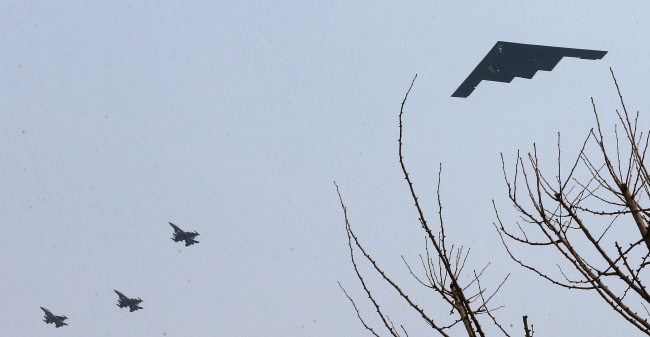B-2 stealth bombers conduct firing drills on peninsula
Seoul to import bunker busters in May to strengthen deterrence against North Korea
By Korea HeraldPublished : March 28, 2013 - 20:39
Two U.S. B-2 stealth bombers carried out firing drills over the peninsula openly for the first time on Thursday in an apparent warning to North Korea after it threatened to strike U.S. targets and its allies.
The centerpiece of the U.S. Air Force’s long-range strike arsenal from Whiteman Air Force Base in Missouri came here as part of the ongoing allied Foal Eagle field training exercise, the Combined Forces Command here said in a press release.
The U.S. Strategic Command sent the bombers to demonstrate the U.S.’ commitment and capability to defend South Korea and provide extended deterrence to its allies in the Asia-Pacific region, it said.
They flew over the Osan U.S. Air Force base in Pyeongtaek, Gyeonggi Province.
The bombers’ participation in the Foal Eagle drills that continue to the end of this month came just hours after Seoul’s Defense Minister Kim Kwan-jin and U.S. Secretary of Defense Chuck Hagel had their first telephone exchanges.
The centerpiece of the U.S. Air Force’s long-range strike arsenal from Whiteman Air Force Base in Missouri came here as part of the ongoing allied Foal Eagle field training exercise, the Combined Forces Command here said in a press release.
The U.S. Strategic Command sent the bombers to demonstrate the U.S.’ commitment and capability to defend South Korea and provide extended deterrence to its allies in the Asia-Pacific region, it said.
They flew over the Osan U.S. Air Force base in Pyeongtaek, Gyeonggi Province.
The bombers’ participation in the Foal Eagle drills that continue to the end of this month came just hours after Seoul’s Defense Minister Kim Kwan-jin and U.S. Secretary of Defense Chuck Hagel had their first telephone exchanges.

During the bilateral talks, the two defense chiefs reaffirmed the strength of the alliance. Hagel highlighted the “steadfast” U.S. commitment to the peninsula’s security including “extended deterrence capabilities,” according to Pentagon spokesperson George Little.
Extended deterrence refers to the U.S.’ stated commitment to deterring military threats to its key Asian ally of South Korea, including those from nuclear weapons and other weapons of mass destruction.
The new Pentagon chief also pointed to the recently signed joint counter-provocation plan as a mechanism to enhance bilateral consultation and coordination of the allies’ responses to North Korean aggression.
This mission by two B-2 Spirit bombers, assigned to the 509th Bomb Wing, involved flying more than 6,500 miles to Korea, dropping inert munitions on the Jik Do Range in Gunsan, North Jeolla Province, and returning to the U.S. in a single, continuous mission, the CFC said.
Before the “B-2 Sprit” bombers joined the exercise, another strategic U.S. asset, the B-52 aircraft, along with the 6,900-ton nuclear-powered Cheyenne submarine carried out training missions several times here on the peninsula this month.
Referring to the B-52 bomber as a threat to its nation’s “sovereignty and highest dignity,” North Korea’s Supreme Command said Tuesday it would put its missile and strategic artillery units at the highest level of combat readiness.
The North’s top command also enumerated specific targets such as the U.S. mainland, Hawaii and Guam and other U.S. bases in the Pacific region, not to mention South Korea, ratcheting up tension aggravated by its recent missile and nuclear tests.
The B-2 is one of the most robust aircraft in the world with its capabilities demonstrated in several combat scenarios such as Operation Iraqi Freedom. It can fly more than 6,000 nautical miles without refueling and more than 10,000 nautical miles with just one aerial refueling. Northrop Grumman is the B-2 prime contractor.
The stealth aircraft can carry more than 15 nuclear bombs as well as long-range Joint Air-to-Surface Standoff Missiles, medium-range precision-guided weapons such as the Joint Standoff Weapon, and Joint Direct Attack Munition.
Twenty-one aircraft were built for the original B-2 fleet. Today, the fleet consists of 20 aircraft, following the loss of one in February 2008 in a crash while taking off from Andersen Air Force Base in Guam.
The guided air-to-surface missile mounted on the B-2 bomber is one of the key assets for the U.S. nuclear umbrella that includes submarine-launched ballistic missiles and intercontinental ballistic missiles.
Meanwhile, Seoul plans to introduce Guided Bomb Unit-28, better known as bunker busters, in May. The weapons are capable of destroying North Korea’s underground nuclear and missile-related facilities.
“Washington has recently approved the export of the GBU-28, which it had banned. The military plans to import it sometime in May and deploy it within this year,” a military official told media, declining to be named.
The military sought to introduce it late last year, but could not push for it due to the U.S. approval-related issues. With a budget of some 70 billion won ($62 million), around 200 bunker busters will be introduced to be mounted on fighter jets such as the F-15K.
By Song Sang-ho (sshluck@heraldcorp.com)
-
Articles by Korea Herald


![[Exclusive] Korean military set to ban iPhones over 'security' concerns](http://res.heraldm.com/phpwas/restmb_idxmake.php?idx=644&simg=/content/image/2024/04/23/20240423050599_0.jpg&u=20240423183955)

![[Graphic News] 77% of young Koreans still financially dependent](http://res.heraldm.com/phpwas/restmb_idxmake.php?idx=644&simg=/content/image/2024/04/22/20240422050762_0.gif&u=)



![[Pressure points] Leggings in public: Fashion statement or social faux pas?](http://res.heraldm.com/phpwas/restmb_idxmake.php?idx=644&simg=/content/image/2024/04/23/20240423050669_0.jpg&u=)










